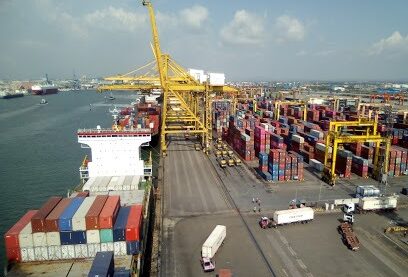
Thailand - ท่าเรือแหลมฉบัง
Laem Chabang Port, Thailand’s prominent deep-sea port, plays a pivotal role in international freight handling. This port, capable of accommodating large vessels like super post-Panamax ships with 50,000 DWT, operates under the supervision of the Port Authority of Thailand (PAT). Over time, the PAT’s responsibilities and size have expanded in tandem with ocean-borne trade growth. Today, it oversees the crucial port infrastructure that bolsters Thailand’s escalating export activities.
Laem Chabang Port: Scope and Capacity
Encompassing approximately a thousand hectares, Laem Chabang Port serves as a pivotal entry point for ocean-going container ships and bulk carriers, acting as a conduit for cargoes destined for transshipment to Bangkok and other parts of Thailand.
Since its inception in 1991, Laem Chabang Port (LCB) has emerged as Thailand’s premier maritime destination. With its strategic location 130 kilometers south of Bangkok in the Chonburi province, LCB has transformed into a robust deep-water facility. This growth has not only been instrumental for the maritime industry but has also ignited regional expansion. Guiding this development is the Port Authority of Thailand (PAT), which has played a pivotal role in crafting the port’s trajectory. The PAT has fostered collaboration between public and private entities by granting concessions to private terminal operators, thereby ensuring efficient individual terminal operations at Laem Chabang Port.
Multiple phases
Laem Chabang Port’s evolution has been structured through multiple phases. Phase 1’s genesis dates back to 1987 when Basin 1 was under development. By 1991, operations commenced at the port’s first two terminals, B1 and B3. Over the ensuing decade, nine additional terminals took shape. Basin 1, a bustling hub, comprises a diverse array of 11 terminals, including seven for containers (A2, A3, B1-B5), a multipurpose terminal, a coastal terminal (A0), passenger and general cargo terminals (A1 and A4), and a car terminal (A5). The 14-meter depth of Basin 1 facilitates the handling of vessels carrying up to 6,500 TEUs. Offering services ranging from cargo handling to ship repair, Basin 1 is equipped to meet varied demands.
The subsequent chapter of development, Phase 2, commenced in 1998 with the creation of Basin 2. Geared toward accommodating the escalating container traffic, this phase underpins Laem Chabang Port’s aspiration to become a global maritime hub. Basin 2 comprises six container terminals (C1-C3 and D1-D3) along with a general cargo terminal (C0).
Auxiliary services, a hallmark of Basin 2, encompass a Container Freight Station (CFS) and enhanced highway connections into Thailand’s hinterland. These enhancements bolster Laem Chabang Port’s appeal as a prime destination for shipping lines traversing key Asia-North America and Asia-Europe trade lanes. With a 16-meter depth, Basin 2’s terminals are primed for even the largest contemporary vessels.
Phase 3 of Laem Chabang Port
The progression of Laem Chabang Port continues unabated with Phase 3. Driven by the Port Authority of Thailand (PAT), this phase is committed to heightening the port’s competitiveness and securing its stature as a gateway to the sub-region. By aligning with Thailand’s Eastern Economic Corridor scheme, Phase 3 integration is underway. The design entails state-of-the-art technology that enhances operational efficiency while minimizing environmental impact, offering swifter services and reduced vessel waiting times.
Phase 3 boasts an impressive vision, featuring an expansive 800-meter by 2,000-meter U-shaped structure with a depth of 18 meters. This configuration ensures the port’s capacity to handle Super-Post Panamax vessels surpassing 10,000 TEUs, with a projected cargo capacity of 8 million TEUs.
The transformation of Laem Chabang Port into an environmentally conscious green port underscores Thailand’s commitment to sustainable practices. Notably, the plan involves transitioning to electric trucks for 10% of all vehicles, equating to approximately 1,000 trucks daily. This shift could translate into a substantial reduction of up to 50 million liters in annual diesel consumption and a significant decrease in carbon emissions. Furthermore, projections indicate an 11.1% annual increase in solar power demand starting from 2023, with a dedicated investment of around 600 million baht.
Expanding Horizons
In parallel, Hanjin Logistics Corporation‘s entry into Thailand’s logistics realm through the establishment of a new container depot at Laem Chabang port marks a significant development. With a 14% stake acquisition in local logistics firm KSP Depot for $830,000, Hanjin secures participation in container freight station (CFS) operations, entailing storage, distribution, and containerized cargo handling.
This strategic move sets the stage for Hanjin’s “one-stop logistics” approach, seamlessly integrated with Thailand’s domestic transportation networks. As the corporation’s expansion plans extend beyond Thailand, encompassing markets like Vietnam, Laos, and Cambodia, the focus remains on forwarding services and cross-border transportation.
Incorporating an expansive area of 9,000 square meters and located 1.6 kilometers from Laem Chabang Port, the Laem Chabang CFS, operated by KSP Depot, underscores the magnitude of this initiative.
Laem Chabang Port’s journey from its inception to its current and future phases stands as a testament to Thailand’s commitment to maritime excellence and sustainability. As Phase 3’s momentum intertwines with innovative green practices and Hanjin Logistics Corporation’s strategic entry, the port’s significance as a trade hub and sustainable entity is further solidified.
Additional Details
- Total area: 10.4 sq km land area
- Cargo throughput: 80 million tonnes (FY 2017)
- Container Capacity: 7.7 million TEUs (FY 2017)
- Draft / maximum vessel size: 14 metres maximum
